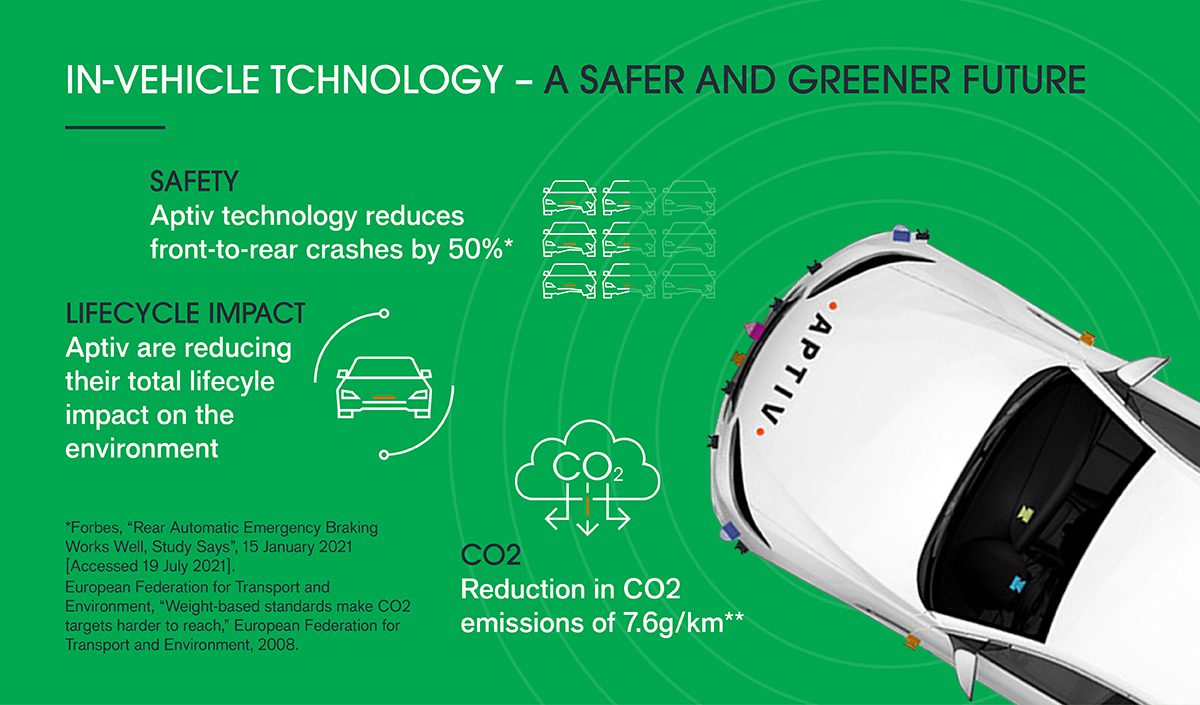Aptiv: making vehicles safer, smarter and more sustainable
While new technology developed by the automotive industry has made modern vehicles safer, more efficient and more environmentally sustainable than ever before, efforts to improve road safety and to reduce the number of road traffic deaths and injuries are still needed.

4 minute read
According to the World Health Organization (WHO), road traffic accidents cause the deaths of 1.3 million people each year, and leave 20-50 million people with non-fatal injuries, creating a huge drain on global healthcare resources.1 More than half of all road traffic deaths are among vulnerable road users, namely pedestrians, cyclists and motorcyclists.2 Car accidents are also bad for the environment too, often resulting in petrol, oil and other fluid leaks that emit harmful chemicals into the environment. Most vehicles involved in an accident are scrapped and replaced, ending up as landfill.
In August 2020, the UN General Assembly adopted a resolution on ‘Improving global road safety’, including an ambitious target of preventing at least 50% of road traffic deaths and injuries by 2030.4 This means there is a real opportunity for companies that are applying state-of-the-art technology to make modern cars safer, smarter, and more sustainable.
Aptiv is a global leader in the automotive technology industry and believes that ‘active safety’ plays a crucial role in preventing road traffic accidents. From its headquarters in North America, Aptiv is delivering mobility technologies, such as radar sensors, driver assistance and automated driving options, that are designed to better connect drivers with their vehicles and surroundings, and to make roads safer for all users.

Safety standardisation
Car safety has come a long way since General Motors performed its first-ever crash test in 1934. In the 1950s, a number of safety features were introduced, including airbags, more reliable braking systems and the three-point seatbelt. The ’50s also saw the introduction of the ‘crumple zone’ concept, where cars could be designed to protect drivers and passengers by absorbing the impact of a collision. Unfortunately, it took considerably longer before these safety features became mandatory in all vehicles.
Of course, car safety begins with the driver. The National Highway Traffic Safety Administration estimates that 94% of all crashes are due to driver error, with an estimated 85% of those crashes caused by:
- Recognition error – such as inattention, internal and external distractions and poor observation;
- Decision error – such as driving too fast, misjudging curves and bends, performing illegal manoeuvres or misinterpreting the actions of other drivers; and
- Performance error – such as overcompensation when steering or braking, or lack of directional control. Sleep, considered to be a non-performance error, is another frequent contributor towards road traffic accidents and crashes.6
Integrated safety features
Safety systems
Active safety systems are the primary safety feature for automobiles, as they play a crucial role in preventing an accident from occurring. Aptiv’s current active safety systems are Level 1 and 2 on the autonomy scale. Level 5, meanwhile, represents a commercially viable, fully autonomous vehicle. As well as offering broader mobility access for drivers, autonomous vehicles are expected to significantly reduce the number of driving-related accidents and crashes.
Aptiv’s blindspot monitor and lane/side-view cameras are good examples of advanced driver-assistance systems. The blind spot monitor alerts drivers to obstacles present in blind spots around the vehicle and the lane/side-view cameras keep the driver aware of traffic during lane changes. Aptiv estimates these two forms of technology could help prevent almost 400,000 crashes in the US per year.
1 World Health Organization, “Road traffic injuries”, 7 February 2020. [Accessed 19 July 2021].
2 World Health Organization, “Road traffic injuries”, 7 February 2020. [Accessed 19 July 2021].
3 World Health Organization, “Road traffic injuries”, 7 February 2020. [Accessed 19 July 2021].
4 United Nations, ‘Streets for Life’ campaign, [Accessed 19 July 2021].
5 AA, ‘The evolution of car safety features’, [Accessed 19 July 2021].
6 S. Singh, “Critical Reasons for Crashes Investigated in the National Motor Vehicle Crash Causation Survey,” National Highway Traffic Safety Administration, Washington DC, 2015.
7 PR Newswire, “Introducing Motional: The Hyundai Motor Group and Aptiv Autonomous Driving Joint Venture Unveils New Identity”, 11 August, 2020 [Accessed 19 July 2021].
8 Forbes, “Rear Automatic Emergency Braking Works Well, Study Says”, 15 January 2021 [Accessed 19 July 2021].
These are the views of the author at the time of publication and may differ from the views of other individuals/teams at Janus Henderson Investors. References made to individual securities do not constitute a recommendation to buy, sell or hold any security, investment strategy or market sector, and should not be assumed to be profitable. Janus Henderson Investors, its affiliated advisor, or its employees, may have a position in the securities mentioned.
Past performance does not predict future returns. The value of an investment and the income from it can fall as well as rise and you may not get back the amount originally invested.
The information in this article does not qualify as an investment recommendation.
Marketing Communication.
Important information
Please read the following important information regarding funds related to this article.
- Shares/Units can lose value rapidly, and typically involve higher risks than bonds or money market instruments. The value of your investment may fall as a result.
- Shares of small and mid-size companies can be more volatile than shares of larger companies, and at times it may be difficult to value or to sell shares at desired times and prices, increasing the risk of losses.
- If a Fund has a high exposure to a particular country or geographical region it carries a higher level of risk than a Fund which is more broadly diversified.
- This Fund may have a particularly concentrated portfolio relative to its investment universe or other funds in its sector. An adverse event impacting even a small number of holdings could create significant volatility or losses for the Fund.
- The Fund follows a sustainable investment approach, which may cause it to be overweight and/or underweight in certain sectors and thus perform differently than funds that have a similar objective but which do not integrate sustainable investment criteria when selecting securities.
- The Fund may use derivatives with the aim of reducing risk or managing the portfolio more efficiently. However this introduces other risks, in particular, that a derivative counterparty may not meet its contractual obligations.
- If the Fund holds assets in currencies other than the base currency of the Fund, or you invest in a share/unit class of a different currency to the Fund (unless hedged, i.e. mitigated by taking an offsetting position in a related security), the value of your investment may be impacted by changes in exchange rates.
- When the Fund, or a share/unit class, seeks to mitigate exchange rate movements of a currency relative to the base currency (hedge), the hedging strategy itself may positively or negatively impact the value of the Fund due to differences in short-term interest rates between the currencies.
- Securities within the Fund could become hard to value or to sell at a desired time and price, especially in extreme market conditions when asset prices may be falling, increasing the risk of investment losses.
- The Fund could lose money if a counterparty with which the Fund trades becomes unwilling or unable to meet its obligations, or as a result of failure or delay in operational processes or the failure of a third party provider.
Specific risks
- Shares/Units can lose value rapidly, and typically involve higher risks than bonds or money market instruments. The value of your investment may fall as a result.
- Shares of small and mid-size companies can be more volatile than shares of larger companies, and at times it may be difficult to value or to sell shares at desired times and prices, increasing the risk of losses.
- The Fund follows a sustainable investment approach, which may cause it to be overweight and/or underweight in certain sectors and thus perform differently than funds that have a similar objective but which do not integrate sustainable investment criteria when selecting securities.
- The Fund may use derivatives with the aim of reducing risk or managing the portfolio more efficiently. However this introduces other risks, in particular, that a derivative counterparty may not meet its contractual obligations.
- If the Fund holds assets in currencies other than the base currency of the Fund, or you invest in a share/unit class of a different currency to the Fund (unless hedged, i.e. mitigated by taking an offsetting position in a related security), the value of your investment may be impacted by changes in exchange rates.
- When the Fund, or a share/unit class, seeks to mitigate exchange rate movements of a currency relative to the base currency (hedge), the hedging strategy itself may positively or negatively impact the value of the Fund due to differences in short-term interest rates between the currencies.
- Securities within the Fund could become hard to value or to sell at a desired time and price, especially in extreme market conditions when asset prices may be falling, increasing the risk of investment losses.
- The Fund could lose money if a counterparty with which the Fund trades becomes unwilling or unable to meet its obligations, or as a result of failure or delay in operational processes or the failure of a third party provider.
- In respect of the equities portfolio within the Fund, this follows a value investment style that creates a bias towards certain types of companies. This may result in the Fund significantly underperforming or outperforming the wider market.
Specific risks
- Shares/Units can lose value rapidly, and typically involve higher risks than bonds or money market instruments. The value of your investment may fall as a result.
- Shares of small and mid-size companies can be more volatile than shares of larger companies, and at times it may be difficult to value or to sell shares at desired times and prices, increasing the risk of losses.
- The Fund follows a sustainable investment approach, which may cause it to be overweight and/or underweight in certain sectors and thus perform differently than funds that have a similar objective but which do not integrate sustainable investment criteria when selecting securities.
- The Fund may use derivatives with the aim of reducing risk or managing the portfolio more efficiently. However this introduces other risks, in particular, that a derivative counterparty may not meet its contractual obligations.
- If the Fund holds assets in currencies other than the base currency of the Fund, or you invest in a share/unit class of a different currency to the Fund (unless hedged, i.e. mitigated by taking an offsetting position in a related security), the value of your investment may be impacted by changes in exchange rates.
- When the Fund, or a share/unit class, seeks to mitigate exchange rate movements of a currency relative to the base currency (hedge), the hedging strategy itself may positively or negatively impact the value of the Fund due to differences in short-term interest rates between the currencies.
- Securities within the Fund could become hard to value or to sell at a desired time and price, especially in extreme market conditions when asset prices may be falling, increasing the risk of investment losses.
- The Fund could lose money if a counterparty with which the Fund trades becomes unwilling or unable to meet its obligations, or as a result of failure or delay in operational processes or the failure of a third party provider.
- The Fund follows a growth investment style that creates a bias towards certain types of companies. This may result in the Fund significantly underperforming or outperforming the wider market.
